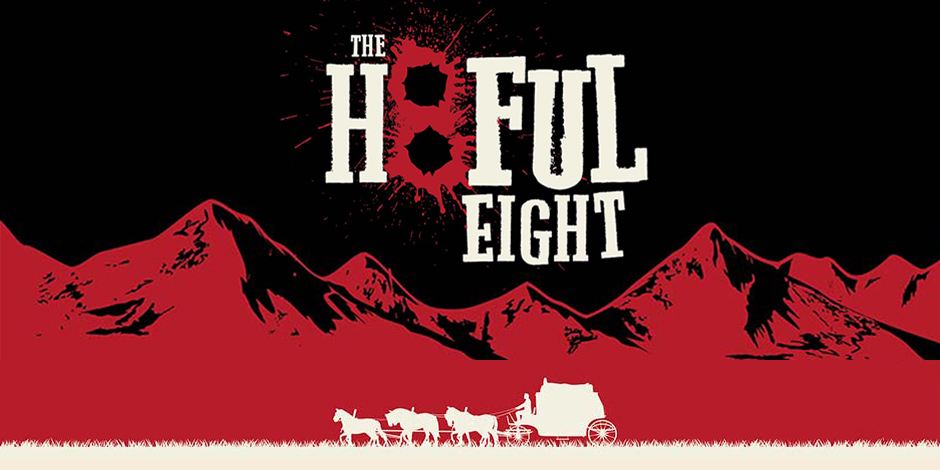
What follows is not a review of Quentin Tarantino’s The Hateful Eight, but rather the observations of a dramaturg on some of the more theatrical aspects of mainstream cinema’s favourite mix-tape style auteur.
In the run up to my seeing The Hateful Eight at the cinema, I was tipped off by a number of friends to this film containing more theatrical elements than some of Tarantino’s other work.
I should preface this of course by highlighting that by theatrical I do not necessarily mean exaggerated, which in some common usage it is synonymous with, but rather to mean that which utilises techniques drawn from or commonly used in theatrical form.
And, following my attendance at the pictures tonight to see it for myself, I was interested to observe a few particularities about the more theatrical aspects of The Hateful Eight from my admittedly skewed perspective.
In a number of ways, of course, it should come of no surprise to note cross-pollinations between theatre and cinema, given their cultural overlap, and it should especially come as no surprise to notice these aspects in the work of Tarantino, whose work like most theatre (historically speaking) subscribes formally to the mechanics of the dramatic (more on this another time!).

- Firstly and most strikingly theatrical is Tarantino’s extended use of a single environment for most (but not all) of the film. Broadly speaking, modern theatre since the pioneering scenography of the Meiningen Company has worked within an established precedent for a limited number of physically crafted environments within which the activity of the piece would commence. For much theatre work too, this precedent comes as a matter of pragmatism, a condition which is rarely the case for cinema. In the future I hope to return to the subject of cinema which adopts these conditions as a stylistic choice (Such as Lars Von Trier’s Dogville), but for now it suffices to say that the physical limitations of place usually present in theatre are rarely a formal requirement for cinema. As such, the decision for a bulk of the film to occur under a single roof amidst a spectacular special effect rendering of a blizzard, is likely to instil a particular claustrophobia in its viewers. Another notable effect of this decision is for the action to acquire an Aristotelian quality, so named after the qualities derived from Aristotle’s Poetics of a unity of action, time, and place. Which not exclusively theatrical, these unities are a frequent formal component in theatrical and performance based work, and less frequently used in mainstream narrative-cinema.

- Another feature that caught my theatre-going eye, was a much lauded aspect of Tarantino’s work as a writer/director, that being his frequent use of intensely delivered monologues. Most famous perhaps are those delivered with eye-popping, tension-ratcheting ferocity by Samuel L. Jackson but they mark a considered feature of Tarantino’s style as an auteur. Typically these encounters provide the opportunities for gradual escalation of tension, and eventually provide the kindling for the subsequent ignition of violence. For a fitting comparison in the theatre, we might turn to work of Philip Ridley, a polymathic artist, director, and writer known for his intensely theatrical writing for the stage. Ridley too revels in the power of the tightly crafted speech, creating verbose ‘Party Pieces’ (As Heroes Theatre’s Eve Nicol once described them in the run up her tremendous production of The Pitchfork Disney).

- In a technique commonly associated with the work of Bertolt Brecht (but by no means exclusively, Piscator and silent cinema providing choice examples of the mechanic in use), Tarantino makes use of chapter headings, replete with surtitles surmising the next section of the story. As well as investing in a healthy dosage of dramatic irony, by offering us a brief but elliptical glimpse into the future that is denied to the characters of the film, but also by providing a structural break in proceedings, the technique offers an easy method of transitioning an audience between variations in emphasis, theme, and style.

- Structurally, the film bears something of a resemblance to D. C. Jackson’s Kill Johnny Glendenning with its use of an altered perspective later in the drama of events preceding the start of the narrative. In both instances, the altered perspective on events is used to realise the altered states of play pertaining to an episode of violence, chaos, and confusion, allowing us to see the end result of a fast-moving state of play whilst also being able to appreciate an enhanced perspective on the climax of the drama, by offering an alternative view on the sculptural quality of an arc punctuated by horrific violence.

- At points The Hateful Eight makes use of a narrator, a device more frequently favoured in the theatre than in the cinema, due in part to cinema’s ability to provide cut-aways, but also in part down to a theatrical usage of narrators as a bridge between audience and performers.
I hope to return to some of these topics over the coming weeks from my skewed perspective as a dramaturg, as well as discuss other pieces and what fascinates me most about them: their dramaturgy. I look forward to the challenge of discussing dramaturgy in a meaningful, clear, and interesting way, and I hope that some of you will join me in doing so….let’s begin.
Elliot Roberts
Reblogged this on Signed, Never yours but always truly.
LikeLike